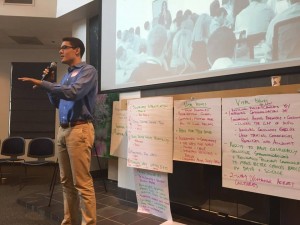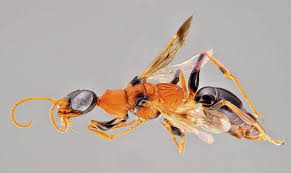California Agriculture Secretary Karen Ross was honored to deliver the commencement address for the UC Berkeley College of Natural Resources on May 16, 2015. Her remarks:
Dean, faculty members and staff, families, and—of course—students and graduates. What a great night for a college graduation. Congratulations to you for your achievement!
You will leave here tonight holding a degree from one of the finest universities in our country – and the greatest public university in the world. This university – whose roots are in agriculture – is steeped in tradition and blessed with the very best minds in the world studying, teaching, mentoring – being leaders in their disciplines.
Given the outstanding academic experience you have had, I hope you feel ready to find your life purpose and pursue your passion. Our world needs you – your intellect, your energy and your commitment to serve.
When I reflect on the pathway my life has taken, I laugh to think that I spent my first 25 years wanting to get away from agriculture. I grew up on a farm in western Nebraska and graduated from the University of Nebraska as an English major of all things! I earned my degree while I worked full time and attended seven and a half years in night classes.
But then I got into politics and experienced the powerful connection of public policy to food access, farming and the environment. That’s how I discovered my passion! Little could I imagine that my life’s work would bring me to this special place – California.
Many of you are Californians by birth. The rest of you are Californians because you chose to study in one of the most innovative and dynamic places in the world. California is a place like no other – a land of dreamers and visionaries. I hope you choose to stay here.
What makes California so special are the individuals that brought it to life:
- Students and scholars came here because this is where the “next thing” would happen. Today, our universities grace the list of places the rest of the world watches with admiration and anticipation.
- Farm workers came here because this is where they could support their families and build for a better future. It is a legacy that still lives today.
- Entrepreneurs, inventors and investors came here because we offer unmatched resources. A talented work force; research capacity; infrastructure; and, raw materials. California is still that destination.
- Visitors and vacationers came here because… well, I really don’t even have to explain it. It’s California! Today more visitors come to California than ever before.
This place is just that special. At its best, California is a mirror that shows each of us what we hope to become. And your university – now, your “alma mater” – has put you in the envious position of advancing along that line, toward turning hope into accomplishment.
You find yourselves at a starting point that has no prescribed ending and no defined path forward. Yet, the future with all the challenges it holds is exciting and the opportunities are indescribable!
Our state’s history is fraught with challenges, some of which seemed downright intractable. Economic downturns and fitful recoveries. Natural disasters. And, of course, droughts that teach us the critical importance of water that makes all the things we love about California work – our economy; our bountiful production of nutritious food; our treasured environment; our very quality of life.
Governor Brown said it best in December: “I think this drought will test our imagination and our science, our technology and our political capacity to collaborate.”
And it is testing us as we debate everything from which crops we should grow to the value of lawns and golf courses, the use of gray water and desalination and how much water should be dedicated to the environment. Each of these is part of the equation, but individually these arguments all miss the point.
The point is that California’s diversity is its strength. We know we have the range of viewpoints, the depth of combined experience, and the finely-honed innovative spirit to overcome, to evolve, to become better together. When we collectively realize this and embrace that strength, we’ll work together rather than trying to solve problems by pointing fingers and pretending that changing just one thing will fix it.
We understand that droughts and extreme weather events will be a prevalent aspect of our future because of climate change. And, with Governor Brown’s leadership we are embracing our collective power to address it.
I know that climate change has been a topic in your academic experience, and with good reason. The rate at which the global atmospheric concentration of carbon dioxide is rising creates a sense of urgency to how we address such a complex problem. Reaching 400 parts per million for the first time in recorded history is not the right milestone! How my generation – and yours – defines and responds to this challenge will have an enormous impact on the quality of life, the opportunities and the limitations that future generations will face, for better or worse.
In similar fashion, we are dealing with a global epidemic of poor nutrition. Scarcity. Obesity. Malnutrition. Making sure all citizens have access to a reliable supply of nutritious food seems like such a basic step, but in too many places – here and around the world – it remains an elusive goal rather than an achievement. More than 800 million people suffer from chronic hunger. 1.9 billion are overweight, including 600 million who are obese.
According to a recent report from the Chicago Global Affairs Council, nutrition is essential to global food security. “Malnutrition – from undernourishment to obesity – is a global challenge affecting every country on earth and placing more than a quarter of the world’s people at serious health risk.” That places a burden of rising costs on the health care system and lost productivity on the economy.
Despite this challenge, I look at California agriculture and I see a future distinguished by our continued leadership as we work to provide better nutrition to an expanding world population and doing it with less arable land, less available water, and a changing climate. The nutrition piece is essential, and I hope you will be a part of the solution. Under the umbrella of “Natural Resources,” there may be no more demanding – or more rewarding – professional path that you might choose.
In a very real way, California will have even more global influence than it does today. We may not be able to grow enough healthy, nutritious food here in our fertile valleys to feed the whole world… but we can show the world how it can be done.
Research, like the work done at the University of California, will provide the answers. The creativity and innovation of our people in Silicon Valley and all across this state will turn those discoveries into inventions and solutions, even transformational solutions to nourish the world and care for our environment.
Despite drought and climate change. Despite challenges to our global food supply. Despite the uncertainty an unsettled economy can bring, I look at you and I see reason to be hopeful, positive, and inspired. Your generation stands ready – better prepared than any – to embrace challenges like these.
One thing I think we teach here in California is that it’s okay to walk away from the status quo. That’s what farmers do every day. It’s the purpose they have dedicated their lives to. They are mankind’s original innovators, solving whatever problem presents itself that day and that growing season. They are working within a biological system of plants and animals, pests and disease; not enough water or too much, freezes and extreme heat; ever more complicated equipment; and, fast-changing markets. Whatever it is, they figure it out!
Just like that farmer, you are well-positioned to help us fix these grand problems. You have a world-class education. You have learned patience, and process. And you have passion, not just for success, but also for service to your community’s well-being.
I challenge you to put these talents and qualities to good use. I sincerely hope some of you (or all of you) will find your life purpose related to food and agriculture and the stewardship of our precious natural resources. Whatever your life’s work, measure your own success not just in dollars and dividends, but in what you do to take care of this world.
Do it for yourselves and your children – but do it also for generations you will never know, for a time you may never see.
Bring diverse peoples, diverse viewpoints, and diverse expertise together. Help us sustain California as the special place that it is. A California willing to change; willing to step up to the challenge; and always innovating.
The pursuit of your life’s purpose and passion, your contribution to the well-being of your community is what will change the fabric of our landscapes and our tomorrows. Class of 2015, the world is in your hands. I know you’ll take good care of it.









